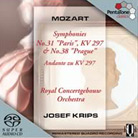October 2003
Krips brings a stately, yet spirited approach to these late Mozart works. The introduction to Symphony No.38 is regal without ever becoming pompous, while the ensuing Allegro is taken at a genial, yet never sluggish, pace. The Andante of the same work shines as an autumnal expression of warmth and serenity. The closing Presto bubbles along joyously and with great humor. The same qualities are to be found in Krips' reading of the "Paris" Symphony, which also includes the alternate Andante movement as an addendum. The Concertgebouw orchestra plays gloriously throughout. It would be hard to imagine better large-orchestra performances of these works. The strings are unanimous in execution while remaining sweet of tone; the ravishing woodwind solos make one wonder if they have ever been better played. This was an original four-channel recording from the "quad" days; and, as usual, the PentaTone producers and engineers have not tampered with it, respecting the artistic integrity of the original master tapes. The strings are spread across a soundstage with adequate width. The woodwinds sound forward yet still behind the strings, and the brass and timpani sound forth from the rear of the stage, using the hall's reverberation for maximum effect. The acoustics of the Concertgebouw are renowned, and the engineers have captured a warm acoustic that does not blur detail. GO BACK TO: |
 Mozart: Symphony No. 31 in D
"Paris," Andante zu KV 297, Symphony No. 38 in D "Prague"
Mozart: Symphony No. 31 in D
"Paris," Andante zu KV 297, Symphony No. 38 in D "Prague" A jovial podium figure, Josef Krips belonged to the Viennese
tradition of music making. His performances were genial and warm, and often quite spirited
as well. Fortunately, unlike Clemens Krauss and Erich Kleiber, two contemporary
"K"s, Krips lived well into the stereo era, so many of his performances were
chronicled in the very best stereo sound of the period. He was under contract to Decca
until 1960. When this contract was not renewed, he signed with Everest to do a Beethoven
symphony cycle, then bounced around labels for a while until he landed a contract to do a
series of Mozart symphonies for Philips in 1972 and 1973. The two symphonies on this
Hybrid multichannel SACD were recorded during that time. These recordings became Krips'
swan song; the beloved maestro passed away in 1974.
A jovial podium figure, Josef Krips belonged to the Viennese
tradition of music making. His performances were genial and warm, and often quite spirited
as well. Fortunately, unlike Clemens Krauss and Erich Kleiber, two contemporary
"K"s, Krips lived well into the stereo era, so many of his performances were
chronicled in the very best stereo sound of the period. He was under contract to Decca
until 1960. When this contract was not renewed, he signed with Everest to do a Beethoven
symphony cycle, then bounced around labels for a while until he landed a contract to do a
series of Mozart symphonies for Philips in 1972 and 1973. The two symphonies on this
Hybrid multichannel SACD were recorded during that time. These recordings became Krips'
swan song; the beloved maestro passed away in 1974.